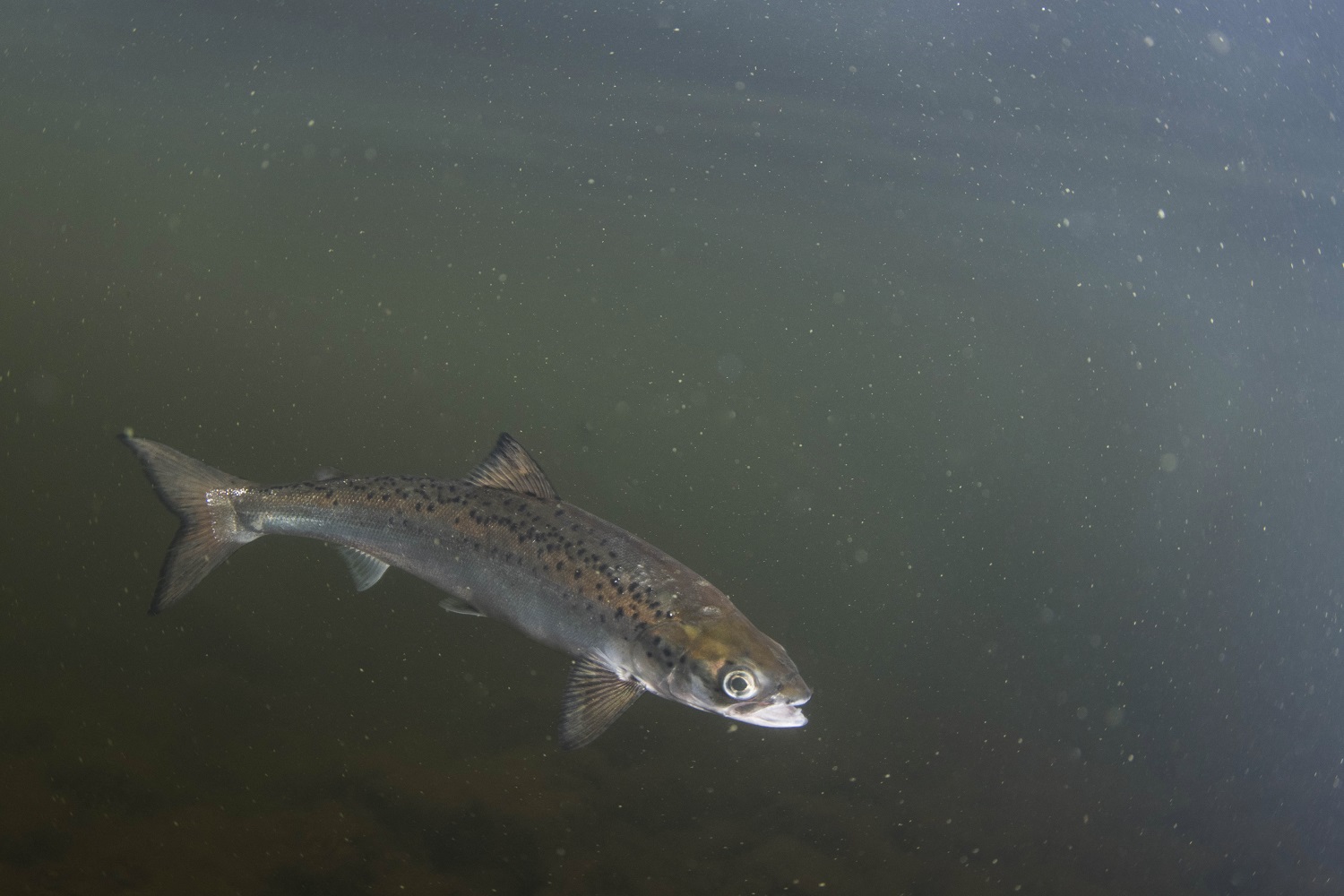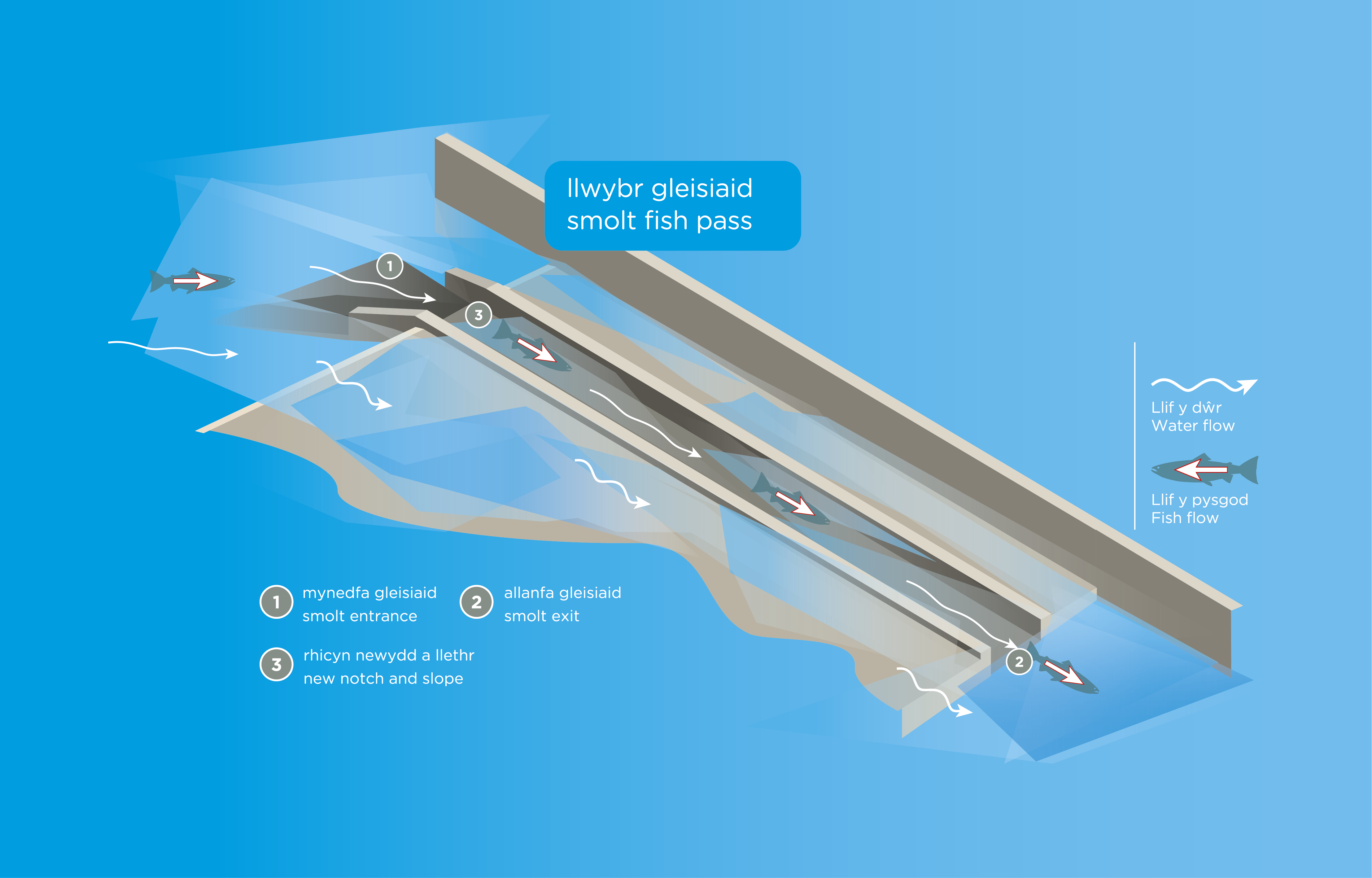Four Rivers for LIFE - Brecon Weir Restoration Project
Overview
Natural Resources Wales’ Four Rivers for LIFE Project aims to improve Brecon Weir for juvenile Atlantic salmon and other fish populations in the River Usk.
The project will install a new smolt pass to help young salmon (smolts) and other fish species to move freely downstream past the weir out to sea.
The work will begin this summer (July 2025).
Smolt is the name given to the stage in a young salmon’s life when it migrates to sea.

Above image: Atlantic salmon smolt (credit Jack Perks Photography).
At the moment Brecon weir is recognised as a significant obstruction to migrating fish swimming downstream to reach the sea.
Recent studies have recorded shoals of smolts trapped above the weir, especially in low flows. This delays their migration making them vulnerable to disease and predation.
Smolts migrate downstream to the sea in spring (April and May time), and in years when spring flows are low they have experienced difficulty passing over structures like Brecon weir.
Salmon and other fish in the river are now struggling and are at risk of becoming extinct in Wales due to habitat loss, man-made barriers, pollution and climate change.
The new smolt pass will complement the existing Larinier fish pass on the far side of the weir, allowing easier migratory access both upstream and downstream.

Above image: design of the proposed new smolt pass.
The importance of the River Usk and Brecon Weir
The River Usk is a SAC (Special Area of Conservation) which means it is of international importance for its wildlife and plants such as Atlantic salmon, lamprey, shad, bullhead, otter and water crowfoot.
The River Usk was once one of the best salmon rivers in Wales, but these days numbers of salmon caught by anglers are at an all-time low.
Salmon are now struggling and are at risk of becoming extinct in some Welsh rivers.
Atlantic salmon spend their juvenile phase in rivers before migrating to sea to grow and mature, and then return to their river of origin to spawn.
Free and unimpeded access between the river and the sea is essential for them to complete their life cycle. To find out more about the salmon life cycle scan this QR Code

Brecon Canal
Brecon weir feeds the Monmouthshire and Brecon Canal and also helps to control the river level for the towns and villages downstream.
The Monmouthshire and Brecon Canal runs for 35 miles (56 km) to Newport. The canal was built between 1797 and 1812 to link Brecon with Newport and the Severn Estuary.
The canalside in Brecon was redeveloped in the 1990s and is now the site of two mooring basins and Theatr Brycheiniog.
Salmon in the River Usk
In 2015 and 2016 there was a catastrophic collapse in the number of young salmon in the River Usk.
Very few or no young salmon were found in areas upstream where they used to breed. These days numbers of salmon caught in the river are at an all-time low.
In 2002 a Larinier fish pass (named after the French engineer who first designed them) was installed on the right bank of the weir, enabling easier access for salmon to swim upstream to breed.
However, smolt migrating downstream will not use the Larinier fish pass as it is on the wrong side of the river for downstream migration.
It works for upstream migration as the weir is on an angle, so the fish follow the flow to the corner and up the pass.
Likewise, with downstream migration and notably in low flows, the smolt hit the top of the weir, follow the flow down to the corner (near the canal abstraction) and congregate here.
What we plan to do
The Four Rivers for LIFE project is working to protect and restore populations of Atlantic salmon in the River Usk.
We will do this by improving fish migration (mainly downstream).
Read more about our plans for Brecon Weir on the panel below.
Tell me more about downstream migration at Brecon weir?
Smolt is the name given to the stage in a young salmon’s life when it migrates to sea. Smolts will migrate downstream to the sea in spring, and in years when spring flows are low they can experience difficulties passing over structures like Brecon weir.
Recent studies have recorded shoals of smolts trapped above the weir, especially in low flows. This delays their migration making them vulnerable to disease and predation.
A new gateway to the sea
The Four Rivers for LIFE project will install a new smolt pass on the weir. The pass will create a passage route (or channel) through the weir for smolts travelling downstream past the weir.
This smolt pass will complement the existing Larinier fish pass on the far side of the weir, ensuring that fish are able to travel both up and downstream during important stages of their life cycle
Latest Updates
August 2024
Structural surveys done in August 2024.
December 2024
A drop-in session was held at Y Gaer, Glamorgan Street, Brecon, LD3 7DW on Thursday 5 December between 2-4pm and a presentation was then given from 5-6pm. This provided the public an opportunity to view designs and speak to the Team.
May 2025
Local contractor Midwest Plant appointed to carry out the work which aims to start on Monday 16 June. The work will take approximately three months to complete, if river flows and weather permits.
July 2025
Work to start w/c Monday 14 July. No footpath closures are planned, but there will be controlled machinery movement on site and along the promenade periodically for the duration of the works.
Frequently Asked Questions
Will you be consulting on plans for the scheme?
We will be holding drop-in sessions in the community to keep people updated. We are also working closely with Powys County Council, Brecon Town Council, Monmouthshire and Brecon Canal and CADW.
Do you have funding to construct the scheme in 2025?
The Four Rivers for LIFE Project is funded by the EU LIFE Programme with support from Welsh Government and Welsh Water.
This work will be fully funded by the project as part of their actions.
Why are you doing this work?
The River Usk and its major tributaries are designated a riverine SAC (Special Area of Conservation) which means it is of international importance for its wildlife and plants such as Atlantic salmon, lamprey, shad, bullhead, otter and water crowfoot.
The River Usk was once one of the best salmon rivers in Wales, with fishing contributing to the local economy. A small amount of sea trout fishing is still also supported by the Usk.
Salmon and other fish in the river are now struggling and are at risk of becoming extinct. In 2015 and 2016 there was a catastrophic collapse in the number of young salmon in the river. Very few or no young salmon were found in areas where they used to spawn. These days numbers of salmon caught in the river are at an all-time low.
Why have salmon numbers dropped so much in the Usk?
Atlantic salmon numbers have been declining across the UK for decades. In the River Usk and tributaries numbers of juvenile salmon suffered a catastrophic collapse in 2015/16. Large areas of traditionally well used spawning tributaries had very few or no juvenile salmon in them. Numbers have not recovered substantially since this crash, and salmon rod catches are now at an all-time low as well.
Isn’t there a fish pass in the weir already?
Brecon weir feeds the Monmouthshire and Brecon Canal and also helps to control the river level for the towns and villages downstream. But the weir is recognised as a significant obstruction to migrating fish swimming up and downstream.
In 2002 a larinier fish pass (named after the French engineer who first designed them) was installed on the right bank of the weir allowing salmon to swim upstream to breed. As a result, salmon are able to easily access the river and tributaries upstream to spawn.
What about downstream migration?
Smolt is the name given to the stage in a young salmon’s life when it migrates to sea. Lots of work has been done to understand the effects of barriers to upstream migration of salmon, but in recent years, we’ve been looking at the impacts on downstream migration.
Smolts will typically migrate downstream to the sea in spring, and in years when spring flows are low they can experience difficulties passing over structures like Brecon weir.
Recent studies have recorded shoals of smolts trapped above the weir, especially in low flows, this delays their migration making them vulnerable to disease and predation.
How will a new smolt pass help?
The Four Rivers for LIFE project will create a new smolt pass on the left bank of the weir. The pass will create a smoother approach flow for smolts travelling downstream past the weir.
This smolt pass will complement the existing larinier fish pass on the far side of the weir, ensuring that young fish are able to travel both up and downstream during important stages of their life cycle.
Will you remove large wood that is stuck on top of the weir?
You will notice large trees and wood around the weir, this is not necessarily a bad thing and does offer a wide range of benefits for the river and wildlife.
The project will not be removing large wood from the weir as part of this work.
Will the project cause any flooding or reduce flood risk in the area?
The scheme has not been specifically designed to reduce flood risk, however, restoring natural river processes, reconnecting floodplains and slowing and spreading flood flows over a greater area upstream may have associated benefits by managing water levels downstream.
Hydrological surveys have been done to assess river flows, the work will not cause any changes to river flows.
Contact Us
For further information you can email the team directly on 4RiversforLIFE@naturalresourceswales.gov.uk
Contact us: 4RiversforLIFE@naturalresourceswales.gov.uk
Contact us: 4RiversforLIFE@naturalresourceswales.gov.uk
Areas
- Usk
Audiences
- Anglers
- Citizens
- citizens
- Coal Authority
- Community Volunteers
- DCWW
- Flooding
- Fly-fishing
- Gwirfoddolwyr Cymunedol
- Llifogydd
- NFU
- Rivers
- Wales Biodiversity Partnership
- water companies
Interests
- Community Engagement
- Community Voulnteering
- Flooding
- Gwirfoddoli Cymunedol
- Llifogydd
- river basin planning
- water framework directive
- water planning
- WFD

Share
Share on Twitter Share on Facebook